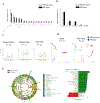Duodenal and pancreatic tissue microbiome profiles of PPI users and non-users
- PMID: 38161092
- PMCID: PMC10842342
- DOI: 10.1016/j.pan.2023.12.010
Duodenal and pancreatic tissue microbiome profiles of PPI users and non-users
Abstract
Factors that influence the pancreas microbiome are not well understood. Regular proton pump inhibitor (PPI) use induces significant alterations in the gut microbiome, including an increase in the abundance of Streptococcus, and may be associated with pancreatic cancer risk. The aim of this study was to examine whether PPI use is associated with pancreatic and duodenal tissue microbiomes. We compared 16S rRNA microbiome profiles of normal pancreatic and duodenal tissue from 103 patients undergoing pancreatic surgery for non-malignant indications, including 34 patients on PPIs, accounting for factors including age, smoking, body mass index and the presence of main pancreatic duct dilation. Histologically normal tissue from the pancreatic head had higher alpha diversity and enrichment of Firmicutes by phylum-level analysis and Streptococcus species compared to normal pancreas body/tail tissues (16.8 % vs 8.8 %, P = .02, and 5.9 % vs 1.4 %, P = .03, respectively). Measures of beta diversity differed significantly between the pancreas and the duodenum, but in subjects with main pancreatic duct dilation, beta diversity of pancreatic head tissue was more similar to normal duodenal tissue than those without pancreatic duct dilation. Duodenal tissue of PPI users had significant enrichment of Firmicute phyla (34.7 % vs. 14.1 %, P = .01) and Streptococcus genera (19.5 % vs. 5.2 %, P = .01) compared to non-users; these differences were not evident in pancreas tissues. By multivariate analysis, PPI use was associated with alpha diversity in the duodenum, but not in the pancreas. However, some differences in pancreas tissue beta diversity were observed between PPI users and non-users. In summary, we find differences in the microbiome profiles of the pancreas head versus the pancreatic body/tail and we find PPI use is associated with alterations in duodenal and pancreatic tissue microbiome profiles.
Keywords: Duodenal microbiome; Pancreas microbiome; Pancreatic cancer; Proton pump inhibitor.
Copyright © 2023 IAP and EPC. Published by Elsevier B.V. All rights reserved.
Figures



References
MeSH terms
Substances
Grants and funding
LinkOut - more resources
Full Text Sources

